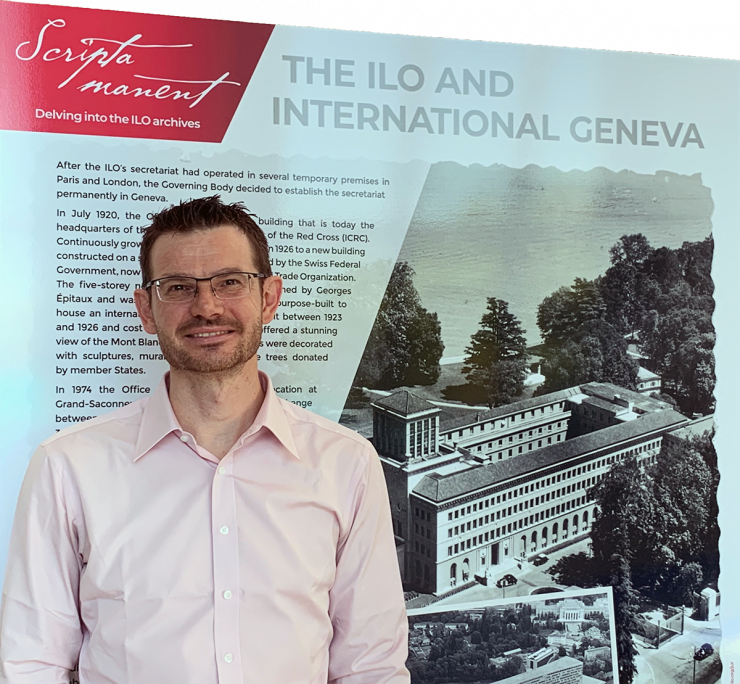Juin 2019
Entretien
A word from… Kilian G. Seeber

See the original interview in French
Kilian G. Seeber has been a Professor at the Faculty of Translation and Interpreting and the Director of the Interpreting Department since 2014. He joined the FTI’s leadership team as Vice-Dean in 2018. Kilian’s main research interest is the cognitive aspects of interpreting, with a particular focus on multimodal processing. As director of two research labs, Kilian has been harnessing new technologies both in research (LaborInt) and training (InTTech). He has organized training courses for the EU institutions and the United Nations and has co-developed the Masters of Advanced Studies in Interpreter Training. In this e-Bulletin, he tells us more about the origins of conference interpreting and a conference the FTI is co-organizing with the ILO later this fall.
On October 3 and 4, the FTI’s Interpreting Department is co-organizing a conference with the International Labour Office (ILO) in Geneva. Can you tell us more about the origin of this event?
This year the ILO is celebrating its centenary. The organization was founded together with the League of Nations, the precursor of today’s United Nations, at the 1919 Paris Peace Conference in Versailles. Incidentally, that conference also marked the birth of a new profession. While French had been the undisputed language of diplomacy for centuries, English was given the same status as French for the first time at an international conference. As a consequence, it was necessary to interpret the exchanges at the conference into both languages. The profession of the conference interpreter was born. As the ILO will be organizing a series of events to commemorate their centenary, we thought it only appropriate to jointly celebrate 100 years of conference interpreting.
Conference interpreting is often associated with the Nuremberg Trials, which were held in Germany after WWII, some 25 years after the Paris Peace Conference. Did conference interpreting really exist before those trials?
The Nuremberg Trials of 1945 were indeed an important milestone in the history of the profession, but far from its beginning. The confusion probably has to do with semantics. Interpreting can be defined by setting, such as conference interpreting, court interpreting, media interpreting or public service interpreting, but also by modality, such as simultaneous, consecutive or whispering. In other words, conference interpreters might work in simultaneous, in consecutive or by whispering their interpretation into a delegate’s ear. The latter two modalities had already been used at the Paris Peace Conference in 1919, at a time when simultaneous interpreting technology was not yet available. It is true that at most multilingual conferences today, interpretation is provided in simultaneous, which would explain why to the uninitiated, the two concepts might appear to be synonymous. In actual fact, however, simultaneous is only one of several modalities available to professionally trained conference interpreters.
The terms are indeed somewhat confusing. Does this mean that the Nuremberg Trials marked the beginning of simultaneous conference interpreting?
The Nuremberg trials were highly mediatized and undoubtedly contributed to making simultaneous interpreting much more widely known in the general population. The true beginnings of simultaneous conference interpreting, however, can be traced back as far as 1925, when the first tests with re-purposed telephonic equipment were carried out at the ILO in Geneva. By 1928 the technology developed by Filene and Finlay was used on a large scale to successfully provide simultaneous interpretation into several languages at the ILO’s Labour Conference. This means that the ILO has always played an important role in the history of the conference interpreting profession—more recently also thanks to its close cooperation with the FTI’s Interpreting Department in training the new generation of conference interpreters. This is also why we decided to co-organize this conference with the ILO.
So what exactly is the topic of the conference? Who should attend and what can we expect to see?
The conference theme is “looking back and looking forward”. In other words, we want to look back over a century of conference interpreting practice, research and training. We want to highlight some of the most important developments and, based on that analysis, try to anticipate upcoming challenges. This means that the conference is as much for scholars and trainers as it is for practitioners. Bringing these three groups of stakeholders together will ensure a lively and hopefully constructive debate about the past, the present and, in particular, the future of conference interpreting. We also wanted to break with the usual conference format, which tends to concentrate on presentations, and instead provide a lot of room for discussion. For each session, we will have an introductory keynote, a limited number of short presentations (Pecha Kucha), and an extended moderated discussion panel with a broad participatory debate. It goes without saying that the event will be multilingual, with interpretation provided into English, French and Spanish.
Sounds like you want to take advantage of the centenary to break the mold of international conferences. Can you already share some of the anticipated highlights?
We have an impressive list of keynote speakers with Jesus Baigorri Jalón opening the session with a talk on conference interpreting practice. We also have Alexis Hervais Adelman, who will provide the backdrop to the discussion on research into conference interpreting, and Jacolyn Harmer, who will be sharing her insight into the training of conference interpreters. The panels are being finalized as we speak, but I can already give away that we’ll be welcoming high-ranking delegations from the United Nations, the European Commission and the European Parliament, alongside top scholars and representatives of the profession. The event will close with a town hall-style meeting on the future of conference interpreting moderated by the Troublesome Terps. As I see it, the main highlights of the event will be the interactive sessions with the audience and the unique opportunity to engage in an open and frank debate with some of the most relevant stakeholders in today’s world of conference interpreting.
